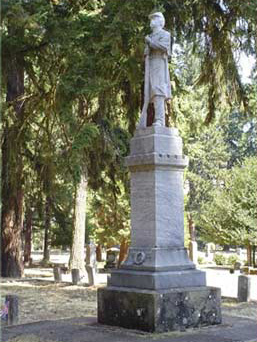G.A.R. Plot
When Union Civil War veteran George Doty passed away in 1887, there was no money to pay his funeral or burial expenses. Doty was a member of Eugene Grand Army of the Republic Post #7 and the Post agreed to pay half of the $30 expense with Lane County picking up the other half of the bill. Thus, George Doty became the first person buried in what is now the GAR plot of the Eugene Pioneer Cemetery. Union veterans of the Civil War formed the G.A.R. in 1866 as a fraternal organization. The GAR became a powerful social and political force in America for decades.
In Eugene, veterans formed the General J.W. Geary, Post #7, of the GAR. The Geary post purchased 38 cemetery plots and an alley to provide for Post members and other Union veterans who needed burial space. This space was reconfigured to hold 66 burials and the GAR monument.
In 1903 Union veteran John Covell’s estate, valued at $2,500, specified that a monument be placed at the GAR plot where he was laid to rest. The bequest was challenged in court by Covell’s relatives, but a Eugene judge ruled in favor of the GAR. The result is the 25-foot blue marble statue of a Union infantryman that stands guard over the soldiers who rest beneath it. The statue was carved in Vermont and shipped by rail to Eugene. The 8-ton statue was brought to the cemetery by an 8-horse team and raised by block and tackle.
In December 2001 vandals broke off the head of the statue and pulverized it. Local artist David Miller was commissioned to sculpt a replacement. An 800-pound block of blue marble was obtained from the same Vermont quarry where the original statue was carved one hundred years before. The new head was installed in February, 2003 and dedicated that Memorial Day.
There are 60 known graves in the Eugene GAR plots, all now marked. There are six women and three children buried among the veterans.
Forty nine of the men buried here served in the army, two in the navy. Thirty four soldiers served in the infantry, ten in the cavalry and five in the artillery. Two served as musicians. Illinois is the most heavily represented state, with eleven buried in the GAR plots, followed by Minnesota and Wisconsin, with five each. One veteran, James Brown of the 47th Ohio Infantry, was captured by the Confederates and survived confinement at the infamous Andersonville prisoner of war camp. And one burial, Charles W. Mead, was a soldier in the Spanish American War
After George Doty was buried in 1887, GAR plot interments continued for more than 50 years. The last person to be laid to rest here was Mary Townsend, widow of veteran Horatio Townsend and she was buried next to her husband in 1939.

